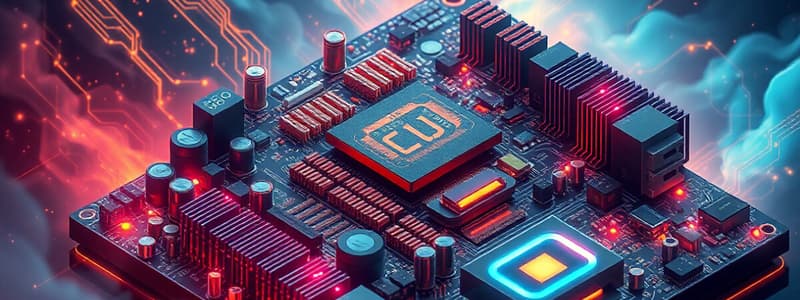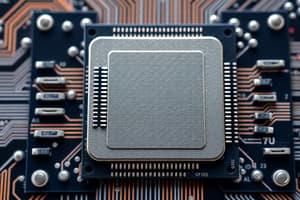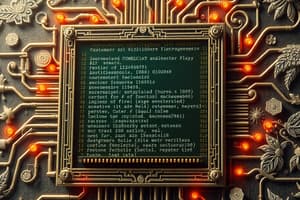Podcast
Questions and Answers
Optical discs store items in a single track that spirals from the edge to the center of the disc.
Optical discs store items in a single track that spirals from the edge to the center of the disc.
False (B)
Tape is a magnetically coated ribbon capable of storing large amounts of data.
Tape is a magnetically coated ribbon capable of storing large amounts of data.
True (A)
A tape drive reads and writes data on a smart card.
A tape drive reads and writes data on a smart card.
False (B)
Microfilm stores microscopic images of documents on a roll or sheet film.
Microfilm stores microscopic images of documents on a roll or sheet film.
Enterprise storage is designed for small personal use with minimal data.
Enterprise storage is designed for small personal use with minimal data.
A smart card stores data on a thin microprocessor embedded in the card.
A smart card stores data on a thin microprocessor embedded in the card.
Magnetic stripe cards do not store any information.
Magnetic stripe cards do not store any information.
Optical discs are divided into unevenly sized sectors.
Optical discs are divided into unevenly sized sectors.
The system unit contains electronic components used to process data.
The system unit contains electronic components used to process data.
The motherboard is a type of software component in a computer.
The motherboard is a type of software component in a computer.
The central processing unit (CPU) is also known as the processor.
The central processing unit (CPU) is also known as the processor.
The arithmetic logic unit (ALU) performs only comparison operations.
The arithmetic logic unit (ALU) performs only comparison operations.
Pipelining allows the processor to fetch a new instruction before completing the current one.
Pipelining allows the processor to fetch a new instruction before completing the current one.
Intel and AMD are the leading manufacturers of smartphone batteries.
Intel and AMD are the leading manufacturers of smartphone batteries.
A processor chip generates heat and may require cooling technology.
A processor chip generates heat and may require cooling technology.
Massively parallel processing uses only one processor to execute a single task.
Massively parallel processing uses only one processor to execute a single task.
A byte is made up of eight bits grouped together.
A byte is made up of eight bits grouped together.
The control unit is responsible for carrying out arithmetic operations in a computer.
The control unit is responsible for carrying out arithmetic operations in a computer.
A byte represents a single character in the presence or absence of an electrical charge.
A byte represents a single character in the presence or absence of an electrical charge.
ASCII stands for American Standard Code for Information Communication.
ASCII stands for American Standard Code for Information Communication.
Memory must consist of electronic components storing instructions only.
Memory must consist of electronic components storing instructions only.
Memory size is measured in kilobytes, megabytes, gigabytes, and petabytes.
Memory size is measured in kilobytes, megabytes, gigabytes, and petabytes.
Memory cache speeds up computer processes by storing frequently used instructions and data.
Memory cache speeds up computer processes by storing frequently used instructions and data.
Flash memory can be erased and rewritten electronically.
Flash memory can be erased and rewritten electronically.
Access time in memory refers to the time taken to read data in seconds.
Access time in memory refers to the time taken to read data in seconds.
Plug and Play technology allows computers to configure adapter cards manually after installation.
Plug and Play technology allows computers to configure adapter cards manually after installation.
A USB port can connect up to 127 different peripherals using a single connector.
A USB port can connect up to 127 different peripherals using a single connector.
A smart phone communicates with a notebook computer using an IrDA port.
A smart phone communicates with a notebook computer using an IrDA port.
A hard disk contains circular platters that use magnetic particles to store data.
A hard disk contains circular platters that use magnetic particles to store data.
Optical discs do not require a laser to read and write data.
Optical discs do not require a laser to read and write data.
Cloud storage is an Internet service that provides storage to users.
Cloud storage is an Internet service that provides storage to users.
USB flash drives require an Ethernet port to connect to a device.
USB flash drives require an Ethernet port to connect to a device.
Flashcards are hidden until you start studying
Study Notes
The System Unit
- The system unit is the case that contains all the electronic components.
- The system unit contains the motherboard which houses the main circuit board.
- A computer chip is found on the motherboard and it contains integrated circuits.
The Processor (CPU)
- The processor is also known as the CPU (Central Processing Unit) and is responsible for processing the instructions/data.
- The CPU contains a control unit and an arithmetic logic unit (ALU).
- The control unit directs and coordinates the computer operations.
- The ALU performs mathematical calculations.
- Processors can support pipelining where processing of the next instruction can begin before the first one is finished.
- Intel and AMD are major leading manufacturers of processor chips.
- Processors generate a lot of heat due to operation and require cooling by using heat sinks or liquid cooling technology.
- Parallel processing uses multiple processors for a single task or program.
- Massively parallel processing uses hundreds or thousands of the processors simultaneously.
Data Representation
- Computer circuits represent the binary information using the presence or absence of electrical charge.
- Eight bits grouped together are called a byte. A byte represents a single character in the computer.
- ASCII stands for American Standard Code for Information Interchange, and it's the coding scheme most commonly used to represent data.
Memory
- Memory stores data, instructions and results.
- The system unit has RAM (Random Access Memory) & ROM (Read Only Memory).
- Each location in memory has its own unique address.
- Memory size is measured in KB, MB, GB, and TB.
- Memory cache speeds up processing by storing frequently used instructions and data.
- Flash memory is electronically erasable and rewritable.
- CMOS technology provides high speeds and consumes little power.
- Access time is the time it take the processor to read from memory.
Expansion Slots & Adapter Cards
- Plug and Play allows the computer to automatically configure peripherals as you install them.
- Removable flash memory includes:
- Memory cards
- USB flash drives
- PC Cards/ExpressCard modules
Ports & Connectors
- A USB port can connect up to 127 different peripherals with a single connector.
- Bluetooth wireless port adapter converts a USB port into a bluetooth port.
- An IrDA port allows communication between devices via infrared signals.
Power Supply
- The power supply provides the necessary electrical current to the computer.
Keeping Your Computer or Mobile Device Clean
- You can keep your computer or mobile device clean by removing dust from cooling fans, keyboard, monitor and other areas.
Storage
- Storage is the ability to save data or information. It can be internal or external.
- Capacity refers to the total amount of data that can be stored.
- A storage device is the hardware that saves and retrieves data from storage media.
Hard Disks
- A hard disk contains one or more inflexible, circular platters which are coated with a magnetic material that stores data.
- Hard disks can store data using longitudinal recording or perpendicular recording.
- Hard disks typically have a hard disk controller. It is responsible for managing data flow between the hard disk and the other system components.
Flash Memory Storage
- Flash memory storage is a non-volatile type of storage that uses flash memory chips to store data.
- Flash memory storage devices are commonly used in USB flash drives, memory cards, and solid-state drives (SSDs).
Cloud Storage
- Cloud storage involves storing data on remote servers instead of local hard drives.
- Cloud storage services can be paid or free and offer a range of features and storage capacities.
Optical Discs
- Optical discs are flat, round media using a laser to write and read from the disc.
- They are used for storing software, data, photos, movies and music.
- Optical Discs can be read-only (CD-ROM), rewritable (CD-RW), or write-once (CD-R).
Other Types of Storage
- Tape is a magnetically coated ribbon that can store large amounts of data.
- Magnetic stripe cards store data on a magnetic stripe.
- Smart cards store data on a thin microprocessor embedded in a card.
- Microfilm and microfiche store microscopic images of documents on a roll or sheet of film.
- Enterprise storage stores immense amounts of data for large organizations.
Studying That Suits You
Use AI to generate personalized quizzes and flashcards to suit your learning preferences.




